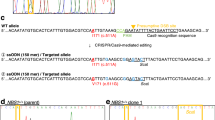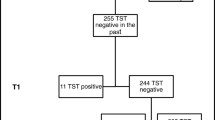Abstract
Purpose
Werner’s syndrome (WS) is a recessive disorder of premature onset of processes associated with aging. Defective DNA repair has been reported after exposure of cells isolated from WS patients to DNA-damaging agents. The germline 4330T>C (Cys1367Arg) variant in the WS gene (WRN) has been associated with protection from age-related diseases, suggesting it has a functional role. We studied whether the 4330T>C variant confers altered drug sensitivity in vitro.
Methods
4330T>C was genotyped in 372 human lymphoblastoid cell lines (LCLs) from unrelated healthy Caucasian individuals using a TaqMan-based method. The study was powered to detect the effect of the 4330T>C genotypes after exposure to camptothecin (based upon preliminary data). The effect of the 4330T>C variant on the cytotoxicity of etoposide, carboplatin, cisplatin and daunorubicin was also tested. WRN expression in 57 LCLs was measured by microarray.
Results
No significant difference between the IC50 of the cells was observed among genotypes (P = 0.46) after exposure to camptothecin. No association was also observed for etoposide, carboplatin, cisplatin, and daunorubicin (ANOVA, P > 0.05). WRN expression also did not vary across genotypes (ANOVA, P = 0.37).
Conclusion
These results suggest that this nonsynonymous variant has relatively normal function at the cellular level.



Similar content being viewed by others
Abbreviations
- WS:
-
Werner’s syndrome
- WRN:
-
Werner’s syndrome gene
- LCLs:
-
Lymphoblastoid cell lines
- 4NQO:
-
4-Nitro-quinoline-1-oxide
- SNPs:
-
Single nucleotide polymorphisms
- EBV:
-
Epstein–Barr virus
References
Agrelo R, Cheng WH, Setien F, Ropero S, Espada J, Fraga MF, Herranz M, Paz MF, Sanchez-Cespedes M, Artiga MJ et al (2006) Epigenetic inactivation of the premature aging Werner syndrome gene in human cancer. Proc Natl Acad Sci USA 103:8822–8827
Bohr VA, Metter EJ, Harrigan JA, von Kobbe C, Liu JL, Gray MD, Majumdar A, Wilson DM 3rd, Seidman MM (2004) Werner syndrome protein 1,367 variants and disposition towards coronary artery disease in Caucasian patients. Mech Ageing Dev 125:491–496
Castro E, Edland SD, Lee L, Ogburn CE, Deeb SS, Brown G, Panduro A, Riestra R, Tilvis R, Louhija J et al (2000) Polymorphisms at the Werner locus: II. 1074Leu/Phe, 1367Cys/Arg, longevity, and atherosclerosis. Am J Med Genet 95:374–380
Castro E, Ogburn CE, Hunt KE, Tilvis R, Louhija J, Penttinen R, Erkkola R, Panduro A, Riestra R, Piussan C et al (1999) Polymorphisms at the Werner’s locus: I. newly identified polymorphisms, ethnic variability of 1367Cys/Arg, and its stability in a population of Finnish centenarians. Am J Med Genet 82:399–403
Davis T, Wyllie FS, Rokicki MJ, Bagley MC, Kipling D (2007) The role of cellular senescence in Werner syndrome: toward therapeutic intervention in human premature aging. Ann N Y Acad Sci 1100:455–469. Review
Dong YP, Seki M, Yoshimura A, Inoue E, Furukawa S, Tada S, Enomoto T (2007) WRN functions in a RAD18-dependent damage avoidance pathway. Biol Pharm Bull 6:1080–1083
Franchitto A, Pichierri P, Mosesso P, Palitti F (2000) Catalytic inhibition of topoisomerase II in WRN cell lines enhances chromosomal damage induced by X-rays in the G2 phase of the cell cycle. Int J Radiat Biol 76:913–922
Huang RS, Duan S, Shukla SJ, Kistner EO, Clark TA, Chen TX, Schweitzer AC, Blume JE, Dolan ME (2007) Identification of genetic variants contributing to cisplatin-induced cytotoxicity using a genomewide approach. Am J Hum Gen 81:427–437
Huang RS, Kistner EO, Bleibel WK, Shukla SJ, Dolan ME (2007) Effect of population and gender on chemotherapeutic agent-induced cytotoxicity. Mol Cancer Ther 6:31–36
Imamura O, Fujita K, Itoh C, Takeda S, Furuichi Y, Matsumoto T (2002) Werner and Bloom helicases are involved in DNA repair in a complementary fashion. Oncogene 21:954–963
Innocenti F, Mirkov S, Nagasubramanian R, Ramirez J, Liu W, Hennessy K, Das S, Dolan ME, Cook E. Jr., Ratain MJ (2007) Effect of the Werner’s syndrome gene variant 4330C>T on the cytotoxicity of camptothecin in lymphoblastoid cell lines. Proc Amer Assoc Cancer Res 48: Abstract #736
Irizarry RA, Hobbs B, Collin, Beazer-Barclay YD, Antonellis KJ, Scherf U, Speed TP (2003) Exploration, normalization, and summaries of high density oligonucleotide array probe level data. Biostatistics 4: 249–264
Kamath-Loeb AS, Welcsh P, Waite M, Adman ET, Loeb LA (2004) The enzymatic activities of the Werner syndrome protein are disabled by the amino acid polymorphism, R834C. J Biol Chem 279:55499–55505
Kuningas M, Slagboom PE, Westendorp RG, van Heemst D (2006) Impact of genetic variations in the WRN gene on age related pathologies and mortality. Mech Ageing Dev 127:307–313
Lowe J, Sheerin A, Jennert-Burston K, Burton D, Ostler EL, Bird J, Green MH, Faragher RG (2004) Camptothecin sensitivity in Werner syndrome fibroblasts as assessed by the COMET technique. Ann N Y Acad Sci 1019:256–259. Review
Matsumoto T, Shimamoto A, Goto M, Furuichi Y (1997) Impaired nuclear localization of defective DNA helicases in Werner’s syndrome. Nat Genet 16:335–336
Ogburn CE, Oshima J, Poot M, Chen R, Hunt KE, Gollahon KA, Ogburn CE, Rabinovitch PS, Martin GM (1997) An apoptosis-inducing genotoxin differentiates heterozygotic carriers for Werner’s helicase mutations from wild-type and homozygous mutants. Hum Genet 101:121–125
Okada M, Goto M, Furuichi Y, Sugimoto M (1998) Differential effects of cytotoxic drugs on mortal and immortalized B-lymphoblastoid cell lines from normal and Werner’s syndrome patients. Biol Pharm Bull 21:235–239
Otsuki M, Seki M, Kawabe Y, Inoue E, Dong YP, Abe T, Kato G, Yoshimura A, Tada S, Enomoto T (2007) WRN counteracts the NHEJ pathway upon camptothecin exposure. Biochem Biophys Res Commun 355:477–482
Ozgenc A, Loeb LA (2005) Current advances in unraveling the function of the Werner syndrome protein. Mutat Res 577:237–251. Review
Payao SL, de Labio RW, Gatti LL, Rigolin VO, Bertolucci PH, Smith Mde A (2004) Werner helicase polymorphism is not associated with Alzheimer’s disease. J Alzheimers Dis 6:591–594
Pichierri P, Franchitto A, Mosesso P, Palitti F (2000) Werner’s syndrome cell lines are hypersensitive to camptothecin-induced chromosomal damage. Mutat Res 456:45–57
Pichierri P, Franchitto A, Mosesso P, Proietti de Santis L, Balajee AS, Palitti F (2000) Werner’s syndrome lymphoblastoid cells are hypersensitive to topoisomerase II inhibitors in the G2 phase of the cell cycle. Mutat Res 459:123–133
Poot M, Gollahon KA, Rabinovitch PS (1999) Werner’s syndrome lymphoblastoid cells are sensitive to camptothecin-induced apoptosis in S-phase. Hum Genet 104:10–14
Rabik CA, Dolan ME (2007) Molecular mechanisms of resistance and toxicity associated with platinating agents. Cancer Treat Rev 33:9–23. Review
Seiter K, Qureshi A, Liu D, Galvin-Parton P, Arshad M, Agoliati G, Ahmed T (2005) Severe toxicity following induction chemotherapy for acute myelogenous leukemia in a patient with Werner’s syndrome. Leuk Lymphoma 46:1091–1095
Sengupta S, Shimamoto A, Koshiji M, Pedeux R, Rusin M, Spillare EA, Shen JC, Huang LE, Lindor NM, Furuichi Y et al (2005) Tumor suppressor p53 represses transcription of RECQ4 helicase. Oncogene 24:1738–1748
Shen M, Lan Q, Zhang L, Chanock S, Li G, Vermeulen R, Rappaport SM, Guo W, Hayes RB, Linet M et al (2006) Polymorphisms in genes involved in DNA double-strand break repair pathway and susceptibility to benzene-induced hematotoxicity. Carcinogenesis 27:2083–2089
Smith MA, Silva MD, Araujo LQ, Ramos LR, Labio RW, Burbano RR, Peres CA, Andreoli SB, Payão SL, Cendoroglo MS (2005) Frequency of Werner helicase 1367 polymorphism and age-related morbidity i nan elderly Brazilian population. Braz J Med Biol Res 38:1053–1059
Stewart DJ (2007) Mechanisms of resistance to cisplatin and carboplatin. Crit Rev Oncol Hematol 63:12–31. Review
Trikka D, Fang Z, Renwick A, Jones SH, Chakraborty R, Kimmel M, Nelson DL (2002) Complex SNP-based haplotypes in three human helicases: implications for cancer association studies. Genome Res 12:627–639
Ye L, Miki T, Nakura J, Oshima J, Kamino K, Rakugi H, Ikegami H, Higaki J, Edland SD, Martin GM et al (1997) Association of a polymorphic variant of the Werner helicase gene with myocardial infarction in a Japanese population. Am J Med Genet 68:494–498
Yu CE, Oshima J, Fu YH, Wijsman EM, Hisama F, Alisch R, Matthews S, Nakura J, Miki T, Ouais S et al (1996) Positional cloning of the Werner’s syndrome gene. Science 272:258–262
Acknowledgments
This work was supported by the Pharmacogenetics of Anticancer Agents Research (PAAR) Group (http://pharmacogenetics.org) (NIH/NIGMS grant U01GM61393). Data has been deposited into PharmGKB (supported by NIH/NIGMS U01GM61374, hhtp://pharmgkb.org/) under submission numbers PS207132, PS207134, PS206923, PS206922, PS206925 and PS207015 for WRN genotype and sensitivity to camptothecin, cisplatin, etoposide, daunorubicin and carboplatin, respectively. The authors wish to thank the PAAR Lymphoblastoid Cell Core at the University of Chicago (directed at the time of this study by Dr. Amittha Wickrema) for maintaining the lymphoblastoid cell lines used in this study.
Author information
Authors and Affiliations
Corresponding author
Electronic supplementary material
Below is the link to the electronic supplementary material.
Rights and permissions
About this article
Cite this article
Innocenti, F., Mirkov, S., Nagasubramanian, R. et al. The Werner’s syndrome 4330T>C (Cys1367Arg) gene variant does not affect the in vitro cytotoxicity of topoisomerase inhibitors and platinum compounds. Cancer Chemother Pharmacol 63, 881–887 (2009). https://doi.org/10.1007/s00280-008-0793-8
Received:
Accepted:
Published:
Issue Date:
DOI: https://doi.org/10.1007/s00280-008-0793-8




